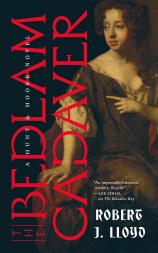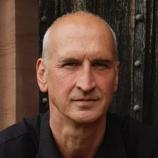Interview: June 27, 2024
In late 17th-century London, rich young women are being kidnapped and then murdered. Harry Hunt, formerly of the Royal Society but now a rich gentleman, is falsely accused. To clear his name, he must rely on his abandoned scientific expertise and battle the full force of the British aristocracy in THE BEDLAM CADAVER, Robert J. Lloyd's third Hunt & Hooke mystery. In this interview conducted by Michael Barson, Senior Publicity Executive at Melville House, Lloyd discusses why he decided to set his latest novel at Bethlehem Hospital (aka Bedlam). He also explains how he handles science and medicine in his series and reveals the one person from another historical period he would like to make the subject of a book.
Question: In your own life as a reader, when did the Bedlam name first come to your attention? And how long have you wanted to write about it?
Robert J. Lloyd: I grew up with the word. I remember clearly my mother complaining about “it being Bedlam in here.” (As I’m one of five children, I’m sure she had a point.) But when it first appeared in my reading, I don’t know. In an Enid Blyton book? Or one of the Jennings books? (It feels more like an Anthony Buckeridge word.)
When researching THE BLOODLESS BOY --- the first in my series of what Melville House now calls the Hunt & Hooke novels --- I looked at a lot of the history of medicine. I knew Robert Hooke had designed the Moorfields building. (My MA thesis was about Hooke). In fact, the Bethlehem Hospital appears on the first page of THE BLOODLESS BOY, as Harry walks across Moorfields on his way to Gresham College. I used it to help set the scene for the various madnesses to follow. In THE POISON MACHINE, Harry walks past it on his way home when he’s drunk and disappointed after his experiment’s failure in front of the Royal Society’s Fellows.
I think the idea crystallized at about this time, as I wrote THE POISON MACHINE, that the next book would be largely based at the hospital. Any research on 17th-century London soon throws up the name “Bedlam.” Even before Hooke’s rebuilding, the asylum was referred to in Jacobean dramas and ballads. These share the same preoccupations I explore in THE BEDLAM CADAVER: Who is mad, who is sane, and who do we trust to distinguish between them? Hooke’s building was so large and impressive that it became a landmark to visit, like Buckingham Palace today. (When he designed it, Hooke was inspired by the Tuileries Palace in Paris.) Ned Ward, in 1703, wrote in his London Spy, “I think they were Mad that Built so costly a Colledge for such a Crack-brain’d Society.”
So I hope you agree that Bedlam was an ideal location for this story, which shows late 17th-century London society fractured by religious zealotry, bigotry and misogyny.
Q: How do you make certain that the limits of science that your protagonists Hunt and Hooke employ during their investigations are entirely accurate for the 1681 period in which this new novel is set?
RJL: Well, here’s the funny thing: I don’t entirely do so, nor do I feel I have to. THE POISON MACHINE is the most free with medicine and science --- “natural philosophical,” they would have said then --- of all my books. Robert Hooke had a delightful way of alluding to his experimental endeavors but jealously guarding how he had achieved them if he felt others might steal his ideas. At other times, of course (and luckily for us), he was transparent with his methods and processes --- for example in his Micrographia, which is a guidebook on how to conduct microscopical observation.
One good example of this is his casual mention of “thirty several ways of flying” he claimed to have invented. In the books, I have Harry having broken his ankle while testing a glider constructed by Hooke, which I have no evidence for whatsoever. Hooke’s “bouncing shoes” propelled their wearer high into the air. No other detail is given, which gives me scope to invent. The experiment Harry fails at in THE POISON MACHINE is an early attempt to show the piezoelectric effect, which isn’t usually claimed to have happened until the 1880s and is generally credited to the Curie brothers. In my fiction, Harry’s experiment, like so many of Robert Hooke’s, seems to have been put aside and not returned to.
At the start of THE BEDLAM CADAVER, Sir Christopher Wren dissects a woman, intending then to make her move. I imply by some form of galvanism. As the dissection is quickly stopped, I see no need to explain further. Such an event would not have made it into the Royal Society’s Philosophical Transactions, and whatever Wren’s methods were are now “lost” to us. Mostly, though, I stick to the late 17th-century notions and descriptions of the world, and I take great delight in using defunct terms and ideas now thought wrongheaded. Of course, one of my themes is the dismissal or distrust of science in current debate. My two heroes try to bring their empirical approach to bear on an absurd and chaotic world.
Q: For the Hunt & Hooke series, you are bound to the personages and events of what the world was like in England and France in the late 17th century. But if you were able to write about a famous person from another point in history, is there one who has always fascinated you?
RJL: A long time ago, when I was an art student doing my Fine Art degree, I was consumed by the ideas of Marcel Duchamp. My work was very much based on his. (Read: I plagiarized him shamelessly.) I have some ideas for a novel based on his life in Paris in the 1920s. These notes have Duchamp as my “investigator,” which might be fun. But so would leaving the framework of the detective novel behind. We’ll see. One day, perhaps.
Q: Have you ever seen the 1946 B-movie Bedlam, which stars the iconic Boris Karloff? “Secrets of the Infamous Madhouse Exposed!” is how RKO Studios advertised it at the time. Though I doubt it has even one percent of the authenticity your novel offers!
RJL: No! But color me intrigued! I will look out for it and report back to you.




